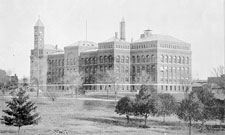 History of the BEP: History of the BEP Buildings (1880-1914)
History of the BEP: History of the BEP Buildings (1880-1914)
 Suggestions for a new location were finally taken seriously in 1877 when the Secretary of the Treasury agreed with the move to a fireproof building. A section of land was considered that was owned by the Federal Government between 14th and 15th Streets and B Street, N.W. (now Constitution Avenue) and B Street, S.W. (now Independence Avenue), currently the area just east of the Washington Monument. The Secretary of the Treasury believed that the better location was nearer the corner of 14th and B Street S.W. placing it in line with the Smithsonian Institution and the Department of Agriculture buildings. However, the area that was chosen was a section of land on the southwest corner of 14th Street and B Streets, just south of the government-owned property.
Suggestions for a new location were finally taken seriously in 1877 when the Secretary of the Treasury agreed with the move to a fireproof building. A section of land was considered that was owned by the Federal Government between 14th and 15th Streets and B Street, N.W. (now Constitution Avenue) and B Street, S.W. (now Independence Avenue), currently the area just east of the Washington Monument. The Secretary of the Treasury believed that the better location was nearer the corner of 14th and B Street S.W. placing it in line with the Smithsonian Institution and the Department of Agriculture buildings. However, the area that was chosen was a section of land on the southwest corner of 14th Street and B Streets, just south of the government-owned property.
Congressional authority approved the new building to be used primarily by the Bureau of Engraving and Printing and by other branches of the Treasury Department. The land was purchased in June 1878, from William W. Corcoran, a banker and founder of the Corcoran Gallery of Art in Washington, D.C. James G. Hill, then Supervising Architect of the Treasury, designed the building. It was completed at a cost of $300,000 and occupied in July of 1880. This building was the first for the Bureau and due to the limited space no other branches were housed there.
Later called “the old brick building” by Bureau of Engraving and Printing employees (known today as the Auditor’s Complex which houses the
US Forest Service), it is Romanesque in style. It is constructed with rolled iron girders and pressed brick, dark red in color. The concrete foundation was poured in September 1878. At the time of construction, it was 220-feet long and 135-feet wide with four stories, a basement, a sub-basement, and a tower. In the tower, there was to be a clock, but it was never installed.
Almost immediately it became obvious that the area surrounding the building was not big enough for the necessary outbuildings. Plans were enacted to obtain the privately owned land to the south then used for outbuildings and for an alley for the horses and carriages. This new brick building changed a rural area with dirt roads to an urban area with cobblestone streets. Over the next thirty years, the building, the land, and the Bureau continually underwent renovations. These included purchasing additional tracts of land, constructing additional wings to the building, and new outbuildings for storage and shops. By 1906, the expansion had reached its limits, and again it was time to consider a move to a new
location.

